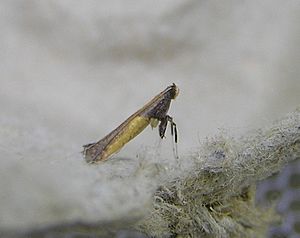Azalea leaf miner facts for kids
Quick facts for kids Azalea leaf miner |
|
|---|---|
 |
|
 |
|
| Scientific classification | |
| Synonyms | |
|
The azalea leaf miner (scientific name: Caloptilia azaleella) is a tiny moth. It belongs to a family of moths called Gracillariidae. This moth is originally from Japan. However, it has spread all over the world. You can find it anywhere there are azalea plants.
Where It Lives
This moth was first found in the Netherlands on azalea plants brought from Japan. Now, you can find it across Europe. It has also traveled to New Zealand and eastern Australia. In places like southern Britain, it lives in sheltered gardens. This includes famous spots like Buckingham Palace and the Royal Botanic Gardens, Kew. It is often seen in greenhouses too.
In the United States, you can find the azalea leaf miner from Florida to Texas. It also lives as far north as Long Island, West Virginia, and the Ohio Valley. On the west coast, it is found in California, Washington, and British Columbia, Canada.
What It Looks Like
The azalea leaf miner moth has dark-brown front wings. It also has a yellow stripe along the front edge of its wings. Its wingspan is about 10 to 11 millimeters. That's roughly the size of a small paperclip!
These moths fly from May to October, depending on where they live. In Britain, they usually have two groups of babies (broods) each year. Sometimes, they even have a third partial brood.
How It Lives
The Caloptilia azaleella moth lays its eggs on azalea plants. It places them under the leaves, near the middle vein. Azalea plants (which are a type of Rhododendron) are the only plants this moth uses.
When the egg hatches, the tiny larva (or caterpillar) starts to eat the inside of the leaf. This creates a tunnel, which is called a mine. Later, the larva rolls the leaf downwards from its tip. This makes a cone shape where it can hide.
When the larva is fully grown, it forms a pale-brown pupa. The pupa is inside a white, silky cocoon. This cocoon is usually spun under a leaf. About a week later, the adult moth comes out of the cocoon and can then mate.

